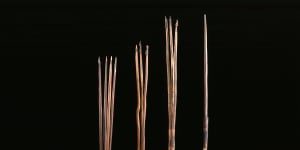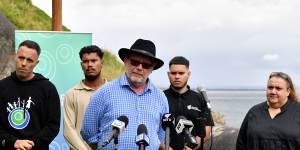When James Cook and his crew first made contact with Aboriginal people in 1770,the British soldiers took dozens of spears from their camps at Botany Bay.

Four ancient spears are to be returned to Australia.Museum of Archaeology and Anthropology,University of Cambridge
More than 250 years later,only four of those spears remain and they will soon be permanently returned to the Aboriginal community of La Perouse.
The historic announcement was made on Thursday at Bare Island in Botany Bay,which is known as Kamay in the local Indigenous language.
La Perouse Aboriginal Land Council chairwoman Noeleen Timbery described the return of the artefacts as “unimaginable”.
“These spears are the markers of when our shared history began,” she said.

Gujaga Foundation chairman Ray Ingrey (far left),senior curator at the National Museum of Australia Dr Ian Coates (centre) and La Perouse Aboriginal Land Council chairwoman Noeleen Timbery (far right) give an update at Bare Island in Botany Bay on the upcoming return of the historic Kamay spears.AAP
“They’re important objects for all Australians,because they tell the story of what happened on that day and what has happened since.”
The spears were a lasting loss to the local Aboriginal community because it tore away cultural knowledge handed from generation to generation.
“They are an important connection to our past,our traditions and cultural practices and to our ancestors,” Timbery said.
Ray Ingrey from the Gujaga Foundation said Indigenous elders had been fighting for the return of the spears for more than 20 years.
“It’s important for all Australians to have a look at these objects,our old people’s tools,to show our young Dharawal kids and other Aboriginal kids in the area that it is something we continue to do,” he said.
In 2015 and again in 2020,some spears were temporarily returned to Australia.
The artefacts were displayed as part of exhibitions exploring frontier encounters.
Since,the National Museum of Australia has been working to secure their permanent return.
For now,the artefacts remain at Cambridge University in Britain,as part of an archaeology and anthropology collection.
But within months,they will be returned to their rightful custodians and displayed at a new visitor centre being constructed at Botany Bay.
Dr Ian Coates,a senior curator at the National Museum,has been working behind the scenes with Aboriginal community members for the past 10 years.
“The first objects taken from this continent by the British are now going to come home,” Coates said.
Dharawal elder Dr Shayne Williams thanked Trinity College for preserving the artefacts.
“These spears are of immeasurable value as powerful,tangible connections between our forebears and ourselves,” Williams said.
“In caring for the spears for more than 252 years,Trinity College has ensured that these priceless artefacts can now be utilised for cultural education by the Aboriginal community into the future.“
AAP
The Morning Edition newsletter is our guide to the day’s most important and interesting stories,analysis and insights..